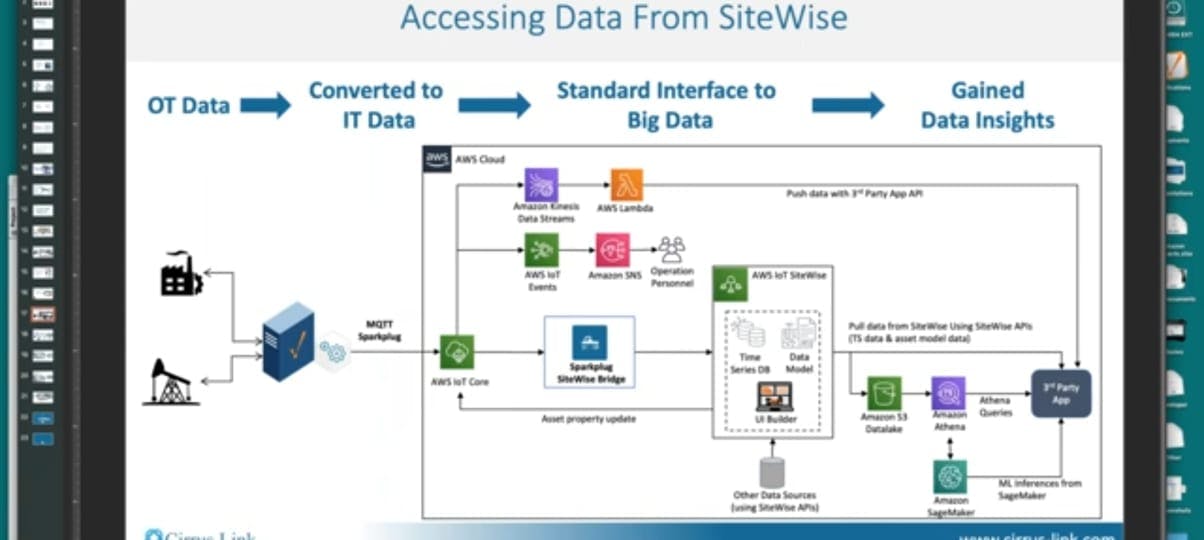Architecture: From Sensors to AWS IoT Site wise

As we discussed earlier in the blog, Aws offers end to end IIOT solution. In this blog let's see how the data flows from sensor to Aws using Ignition an (IIOT Platform). Architecture source (Cirrus link)
In the realm of Industrial IoT, the journey of data from sensors to cloud platforms is a critical process that demands precision and efficiency. The architecture we explore in this blog post leverages cutting-edge technologies to create a seamless data flow that empowers industries to make data-driven decisions.
Architecture Overview:
Device Layer:
At the device layer, various sensors, PLCs (Programmable Logic Controllers), and other industrial devices are deployed across the manufacturing floor.
Ignition Edge, a lightweight version of Ignition, is installed on edge devices to collect and preprocess data locally before sending it to the central Ignition Gateway.
Ignition Gateway:
The Ignition Gateway serves as the central hub for data aggregation, processing, and visualization.
Ignition is configured to communicate with edge devices, collecting real-time data on parameters such as machine status, temperature, and production counts.
AWS IoT Core:
The Ignition Gateway is integrated with AWS IoT Core, a managed service that enables secure and efficient communication between IoT devices and the AWS cloud.
AWS IoT Core facilitates the secure ingestion of data from Ignition into the AWS ecosystem.
AWS Cloud Services:
Amazon S3 (Simple Storage Service):
- Raw and processed data from Ignition is stored securely in Amazon S3 buckets. This ensures durable and scalable storage for historical data.
Amazon IoT Analytics:
- AWS IoT Analytics is used for advanced analytics. It can process large datasets, perform transformations, and generate insights that help in optimizing manufacturing processes.
Amazon Lambda:
- AWS Lambda functions are employed for serverless computing. They can be triggered by specific events, such as data updates, to execute custom code without the need for managing servers.
Flow of Data and Operations:
1. Sensors: The Source of Real-Time Insight
At the heart of any IIoT ecosystem are the sensors, diligently collecting data from the physical environment. Whether it's monitoring temperature variations, pressure levels, or other crucial parameters, these sensors serve as the initial touchpoint for capturing real-time insights.
2. Ignition Edge: Empowering Edge Computing
Ignition Edge steps into the spotlight as the edge computing layer. By processing and analyzing data locally, it reduces latency and optimizes bandwidth usage. Supporting various industrial protocols, Ignition Edge acts as a versatile gateway for communication with a diverse range of sensors and devices.
3. MQTT SparkplugB: Standardizing Communication
The choice of communication protocol is pivotal, and MQTT SparkplugB takes the stage. This lightweight, open-source protocol, coupled with the SparkplugB specification, ensures standardized data representation.
4. AWS IoT Core: Central Hub for IoT Data
AWS IoT Core becomes the central hub for managing and processing IoT data. With support for MQTT, it seamlessly integrates with devices using MQTT SparkplugB. Ensuring secure and reliable communication, AWS IoT Core facilitates the smooth transfer of data from the edge to the cloud.
5. Sparkplug SiteWise Bridge: Bridging the Gap
The Sparkplug SiteWise Bridge plays a crucial role in connecting AWS IoT Core with AWS IoT SiteWise. Acting as a translator, it converts the SparkplugB-formatted data into a format compatible with AWS IoT SiteWise, ensuring a harmonious integration between the two services.
6. AWS IoT SiteWise: Transforming Data into Insights
In the final leg of our journey, we arrive at AWS IoT SiteWise. This fully managed service simplifies the complexities of industrial data by organizing and analyzing it. Creating a digital representation of physical assets, AWS IoT SiteWise empowers industries to monitor, optimize, and enhance their operations through data-driven insights.
I apologize for not going into as much detail in this blog post, the concepts are bit lengthy, therefore I've included some reference blogs and videos.
References:
Comparision between opc-ua, mqqt, sparkplug: IIOT PROTOCOL Guide.
Ignition to Aws : AWS Outposts Architecture - Ignition User Manual 8.1 - Ignition Documentation (inductiveautomation.com)
Iot Bridge - for aws iot sitewise : SCADA system - AWS Cloud - Cirrus Link Solutions (cirrus-link.com)
Live development for IIOT(Youtube): 4.0 solutions